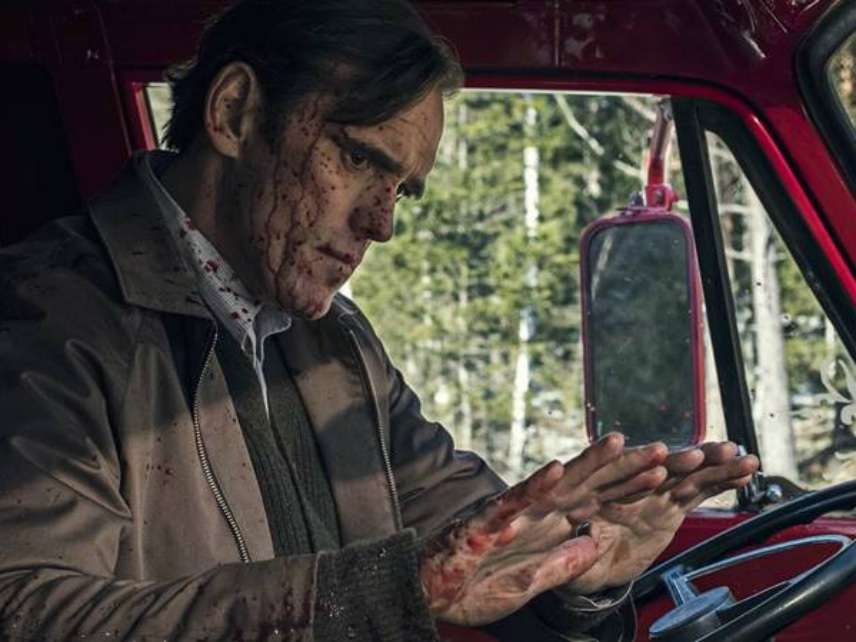Movie Review: The House That Jack Built
Lars von Trier's latest film is heavy on maiming, short on message.

Lars von Trier's blithely vile new serial-killer movie, The House That Jack Built, made its one-day-only U.S. debut in a few lucky cities on Wednesday. It was an unrated "director's cut" of the film—the same one that triggered walkouts at the Cannes Film Festival last May—and it will be succeeded on December 14th by an R-rated version that will linger in theatres for as long as anyone sees a point in screening it.
One wonders how much had to be chopped out of this movie to qualify it for that R rating. Presumably, it lost the shot in which a bound woman's breast is sliced halfway off with a knife (a shot that Trier finds it necessary to show us twice). And probably it will be missing at least parts of a sequence in which the titular killer (Matt Dillon), armed with a rifle, uses a pair of little boys for target practice, bringing one of them down with a head shot and then tracking their wounded mother as she crawls away and finishing her off in a ditch. Then there's the flashback where another little kid—Jack as a larval psycho—cuts a leg off a squirming duckling and throws the frantic creature into the water to flounder and drown. (This spasm of depravity looks alarmingly real, although PETA, which was moved to make "numerous phone calls" about it, says it "confirmed" that the severed leg "was created using movie magic and silicone parts." Both those things.)
Trier is a talented attention hog. His 2009 Antichrist was beautifully filmed (by Anthony Dod Mantle), but also offered us the spectacle of a woman self-administering her own clitoridectomy with a pair of scissors. His coy ramblings about Nazis at a 2011 Cannes press conference ("What can I say, I understand Hitler…Albert Speer I liked") got him banned from the festival until this year – when he returned with this movie, in which we hear a little more about Hitler's favorite architect, and see more concentration camp corpse footage than anyone might want in a film devoted to nothing of more substance than feral sensation. In announcing the movie last year, Trier said it "celebrates the idea that life is evil and soulless." Not much of a message, but it's all he's got.
If you took away all the gaudy excruciation in this two-and-a-half-hour movie—the scenes in which we watch Dillon's Jack as he smacks women in the face with car jacks, strangles and stabs women in their homes, mocks and menaces and terrifies women before removing their body parts—all you'd be left with left with would be Trier's deep thoughts about art. Jack is an artist, for example—he feels the breast-slicing assault to be among his "greatest works." Trier tells us that art is destroyed by the imposition of any moral order, and that "religion has ruined human beings" because it has made them "deny the tiger" in themselves. Jack, of course, is a man who fully embraces his inner tiger.
Does Trier really believe this dorm-room bushwa? He's clearly putting us on, to some extent, but not in any way that's usefully suggestive. Dillon's vulpine agitation is basically humorous, and he has some funny lines. (Addressing a woman lying on the floor after he's just barely failed to kill her, he says, "I'm so sorry. What can I do to make this good again?") But after the first half hour, the laughs start dying along with the characters (well, "characters"—none of the constructs passing through this picture resonate as human beings). And the picture is so awkwardly structured that before long even the bloodiest events grow boring.
It's no surprise, really, that Jack is accompanied on his infernal rounds by a wizened figure he calls Verge (Bruno Ganz)—as in Virgil, as in Dante. In the end, after Jack has finally built his house (with the corpses he's collected in a walk-in refrigerator), he and Verge descend into a fiery netherworld where Jack's unholy journey will finally reach its end. I guess this is a spoiler, of sorts. Sorry. At least it's free.